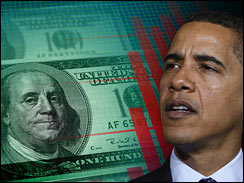
The Associated Press breakdown of approximately $700 billion of the $789 billion economic stimulus bill agreed to by the Senate and House:
Aid To Poor And Unemployed
$40 billion to provide extended unemployment benefits through Dec. 31, and increase them by $25 a week
$20 billion to increase food stamp benefits by 14 percent
$3 billion in temporary welfare payments
Direct Cash Payments
$14 billion to give one-time $250 payments to Social Security recipients, poor people on Supplemental Security Income, and veterans receiving disability and pensions.
Infrastructure
$46 billion for transportation projects, including $27 billion for highway and bridge construction and repair
$8.4 billion for mass transit
$8 billion for construction of high-speed railways and $1.3 billion for Amtrak
$4.6 billion for the Army Corps of Engineers
$4 billion for public housing improvements
$6.4 billion for clean and drinking water projects
$7 billion to bring broadband Internet service to underserved areas
Health Care
$21 billion to provide a 60 percent subsidy of health care insurance premiums for the unemployed under the COBRA program
$87 billion to help states with Medicaid
$19 billion to modernize health information technology systems
$10 billion for health research and construction of National Institutes of Health facilities
State Block Grants
$8 billion in aid to states to defray budget cuts.
Energy
About $50 billion for energy programs, focused chiefly on efficiency and renewable energy, including $5 billion to weatherize modest-income homes
$6.4 billion to clean up nuclear weapons production sites
$11 billion toward a so-called “smart electricity grid” to reduce waste
$13.9 billion to subsidize loans for renewable energy projects
$6.3 billion in state energy efficiency and clean energy grants
$4.5 billion make federal buildings more energy efficient
Education
$47 billion in state fiscal relief to prevent cuts in state aid to school districts, with great flexibility to use the funds for school modernization and repair
$26 billion to school districts to fund special education and the No Child Left Behind law for students in K-12
$17 billion to boost the maximum Pell Grant by $500 to $5,350
$2 billion for Head Start
Homeland Security
$2.8 billion for homeland security programs, including $1 billion for airport screening equipment
Law Enforcement
$4 billion in grants to state and local law enforcement to hire officers and purchase equipment
Taxes
NEW TAX CREDIT: Approximately $115 billion for a $400 per-worker, $800 per-couple tax credits in 2009 and 2010.
For the last half of 2009, workers could expect to see perhaps $13 a week less withheld from their paychecks starting around June.
Millions of Americans who don’t make enough money to pay federal income taxes could file returns next year and receive checks.
Individuals making more than $75,000 and couples making more than $150,000 would receive reduced amounts.
ALTERNATIVE MINIMUM TAX: About $70 billion to spare about 24 million taxpayers from being hit with the alternative minimum tax in 2009.
The change would save a family of four an average of $2,300.
The tax was designed to make sure wealthy taxpayers can’t use credits and deductions to avoid paying any taxes. But it was never indexed to inflation, so families making as little as $45,000 could get significant increases without the change. Congress addresses it each year, usually in the fall.
EXPANDED COLLEGE CREDIT: About $13 billion to provide a $2,500 expanded tax credit for college tuition and related expenses for 2009 and 2010.
The credit is phased out for couples making more than $160,000.
HOMEBUYER CREDIT: $3.7 billion to repeal a requirement that a $8,000 first-time home buyer tax credit be paid back over time for homes purchased from Jan. 1 to August 31, unless the home is sold within three years.
BONUS DEPRECIATION: $5 billion to extend a provision allowing businesses buying equipment such as computers to speed up its depreciation through 2009.
AUTO SALES: $2.5 billion to makes sales tax on paid on new car purchases tax deductible
===
Read the Full Summary of Finance, Ways & Means Provisions in the American Recovery and Reinvestment Act
and Conference Report to Accompany HR-1 – The American Recovery and Reinvestment Act
Also see related posts: The Financial Stability Plan and Executive Order on Health Information Technology.
Additional coverage:
Stimulus Funds Offer Relief to City and State by David M. Halbfinger, New York Times

